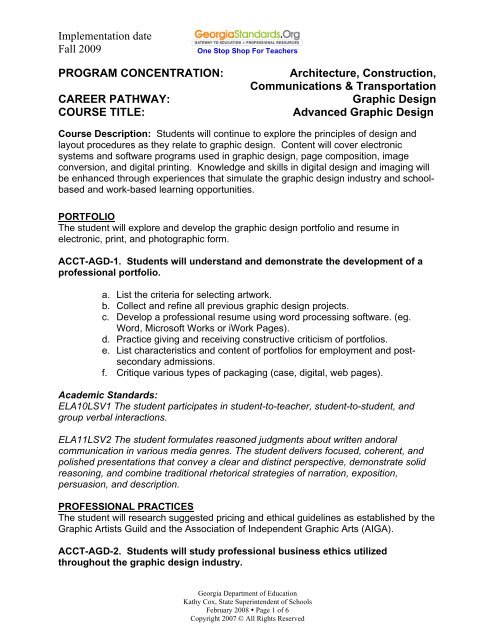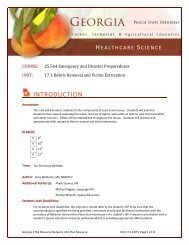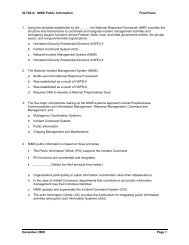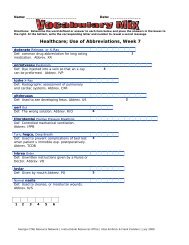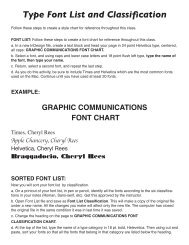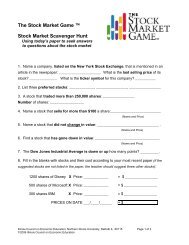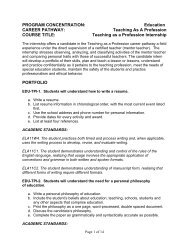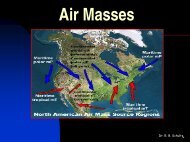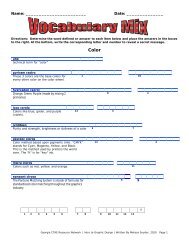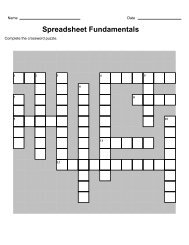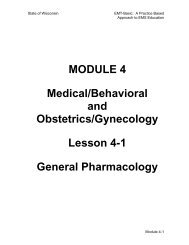Advanced Graphic Design - Georgia CTAE
Advanced Graphic Design - Georgia CTAE
Advanced Graphic Design - Georgia CTAE
Create successful ePaper yourself
Turn your PDF publications into a flip-book with our unique Google optimized e-Paper software.
Implementation dateFall 2009One Stop Shop For TeachersPROGRAM CONCENTRATION:CAREER PATHWAY:COURSE TITLE:Architecture, Construction,Communications & Transportation<strong>Graphic</strong> <strong>Design</strong><strong>Advanced</strong> <strong>Graphic</strong> <strong>Design</strong>Course Description: Students will continue to explore the principles of design andlayout procedures as they relate to graphic design. Content will cover electronicsystems and software programs used in graphic design, page composition, imageconversion, and digital printing. Knowledge and skills in digital design and imaging willbe enhanced through experiences that simulate the graphic design industry and schoolbasedand work-based learning opportunities.PORTFOLIOThe student will explore and develop the graphic design portfolio and resume inelectronic, print, and photographic form.ACCT-AGD-1. Students will understand and demonstrate the development of aprofessional portfolio.a. List the criteria for selecting artwork.b. Collect and refine all previous graphic design projects.c. Develop a professional resume using word processing software. (eg.Word, Microsoft Works or iWork Pages).d. Practice giving and receiving constructive criticism of portfolios.e. List characteristics and content of portfolios for employment and postsecondaryadmissions.f. Critique various types of packaging (case, digital, web pages).Academic Standards:ELA10LSV1 The student participates in student-to-teacher, student-to-student, andgroup verbal interactions.ELA11LSV2 The student formulates reasoned judgments about written andoralcommunication in various media genres. The student delivers focused, coherent, andpolished presentations that convey a clear and distinct perspective, demonstrate solidreasoning, and combine traditional rhetorical strategies of narration, exposition,persuasion, and description.PROFESSIONAL PRACTICESThe student will research suggested pricing and ethical guidelines as established by the<strong>Graphic</strong> Artists Guild and the Association of Independent <strong>Graphic</strong> Arts (AIGA).ACCT-AGD-2. Students will study professional business ethics utilizedthroughout the graphic design industry.<strong>Georgia</strong> Department of EducationKathy Cox, State Superintendent of SchoolsFebruary 2008 • Page 1 of 6Copyright 2007 © All Rights Reserved
Implementation dateFall 2009One Stop Shop For Teachersa. Create a simulated professional client/designer contract.b. Explore pricing options for various graphic design applications.c. Research billing practices and effective operating procedures.Academic Standards:ELA10LSV1 The student participates in student-to-teacher, student-to-student, andgroup verbal interactions.ELA11LSV2 The student formulates reasoned judgments about written and oralcommunication in various media genres. The student delivers focused, coherent, andpolished presentations that convey a clear and distinct perspective, demonstrate solidreasoning, and combine traditional rhetorical strategies of narration, exposition,persuasion, and description.MM2P3 Students will communicate mathematically.MM2P1 Students will solve problems (using appropriate technology).EMPLOYABILITY PREPARATIONThe student will study and practice the employability skills needed to acquire andmaintain employment in the graphic design industry.ACCT-AGD-3. Students will determine requirements for selected careers.a. Determine post-secondary educational requirements for selected careers.b. Research how to locate job listings though a variety of sources (Internet,clubs, associations, networking).c. Complete a practice job application form.d. Study the fundamentals of employer/employee, client/designer workingrelationships.Academic Standards:ELA10LSV1 The student participates in student-to-teacher, student-to-student, andgroup verbal interactions.ELA10W2 The students demonstrates competence in a variety of genres.ELA10W3 The students uses research and technology to support writing.ELA 10Rl2 The student identifies, analyzes, and applies knowledge of theme in literaryworks and provides evidence from the works to support understanding.ADVANCED PROBLEM SOLVING /METHODOLOGYThe student will study the methodology of graphic design as it relates to projectapplication, criticism, and theory.<strong>Georgia</strong> Department of EducationKathy Cox, State Superintendent of SchoolsFebruary 2008 • Page 2 of 6Copyright 2007 © All Rights Reserved
Implementation dateFall 2009One Stop Shop For TeachersACCT-AGD-4. Students will understand the importance of developing a projectfrom concept thru completion.a. Formulate strategies for brainstorming and organizing content.b. Explore different target audiences and the most effective media selectionor mix.c. Evaluate the performance of existing marketing strategies.d. Employ terminology in the field of graphic design.e. Apply creative thinking skills to artistic problems, such as rhetoric.Academic Standards:ELA10W2 The students demonstrates competence in a variety of genres.ELA10W3 The students uses research and technology to support writing.ELA 10Rl2 The student identifies, analyzes, and applies knowledge of theme in literaryworks and provides evidence from the works to support understanding.ACCT-AGD-5. Students will explore the process of project production.a. <strong>Design</strong> a self-marketing logo and collateral (business card, letterhead).b. <strong>Design</strong> self-promoting product (brochure, website, podcast).c. Prepare a time line and budget for selected project.d. List steps and resources needed for project completion.e. Create a CD package design.f. Identify a client and design a promotional poster on their behalf.g. <strong>Design</strong> and produce a product and corresponding packaging.h. <strong>Design</strong> an information site for the web.i. <strong>Design</strong> identity and promotional products for a non-profit organization.j. Research, layout, and produce a booklet in the style of a well-knowngraphic designer.Academic Standards:ELA10W2 The students demonstrates competence in a variety of genres.ELA10W3 The students uses research and technology to support writing.ELA 10Rl2 The student identifies, analyzes, and applies knowledge of theme in literaryworks and provides evidence from the works to support understanding.ACCT-AGD-6. Students will explore digital imaging and multimedia.a. Define the application of digital photography in electronic imaging.b. Define basic terms associated with digital photography.c. Identify various formats for saving electronic images (JPEG, TIFF, PSD,EPS).<strong>Georgia</strong> Department of EducationKathy Cox, State Superintendent of SchoolsFebruary 2008 • Page 3 of 6Copyright 2007 © All Rights Reserved
Implementation dateFall 2009One Stop Shop For Teachersd. Take basic photographs incorporating elements of principles of design.e. Utilize software for making adjustments to electronic images.f. Critique digital photos for appropriate composition.g. Prepare a process color file for separation.h. Prepare electronic files for digital imaging.i. Demonstrate use of computer software for illustration of work as perassignments.j. Analyze and interpret artwork in terms of form, context, purpose, andcritical modes.k. Maintain a sketchbook/journal/electronic file of art produced to add topersonal portfolio.Academic Standard:ELA10RL5 The student acquires new vocabulary in each content area and uses itcorrectly.Reading Across the CurriculumReading Standard CommentAfter the elementary years, students engage in reading for learning. This processsweeps across all disciplinary domains, extending even to the area of personal learning.Students encounter a variety of informational as well as fictional texts, and theyexperience text in all genres and modes of discourse. In the study of various disciplinesof learning (language arts, mathematics, science, social studies), students must learnthrough reading the communities of discourse of each of those disciplines. Eachsubject has its own specific vocabulary, and for students to excel in all subjects, theymust learn the specific vocabulary of those subject areas in context.Beginning with the middle grades years, students begin to self-select reading materialsbased on personal interests established through classroom learning. Students becomecurious about science, mathematics, history, and literature as they form contexts forthose subjects related to their personal and classroom experiences. As studentsexplore academic areas through reading, they develop favorite subjects and becomeconfident in their verbal discourse about those subjects.Reading across curriculum content develops both academic and personal interests instudents. As students read, they develop both content and contextual vocabulary.They also build good habits for reading, researching, and learning. The Reading Acrossthe Curriculum standard focuses on the academic and personal skills students acquireas they read in all areas of learning.<strong>CTAE</strong>-RC-1 Students will enhance reading in all curriculum areas by:Reading in All Curriculum Areas<strong>Georgia</strong> Department of EducationKathy Cox, State Superintendent of SchoolsFebruary 2008 • Page 4 of 6Copyright 2007 © All Rights Reserved
Implementation dateFall 2009One Stop Shop For Teachers-Read a minimum of 25 grade-level appropriate books per year from a variety ofsubject disciplines and participate in discussions related to curricular learning inall areas.-Read both informational and fictional texts in a variety of genres and modes ofdiscourse.-Read technical texts related to various subject areas.Discussing Books-Discuss messages and themes from books in all subject areas.-Respond to a variety of texts in multiple modes of discourse.-Relate messages and themes from one subject area to messages and themesin another area.-Evaluate the merit of texts in every subject discipline.-Examine author’s purpose in writing.-Recognize the features of disciplinary texts.Building Vocabulary Knowledge-Demonstrate an understanding of contextual vocabulary in various subjects.-Use content vocabulary in writing and speaking.-Explore understanding of new words found in subject area texts.Establishing Context-Explore life experiences related to subject area content.-Discuss in both writing and speaking how certain words are subject area related.-Determine strategies for finding content and contextual meaning for unknownwords.<strong>CTAE</strong> Foundation SkillsThe Foundation Skills for Career, Technical and Agricultural Education (<strong>CTAE</strong>) arecritical competencies that students pursuing any career pathway should exhibit to besuccessful. As core standards for all career pathways in all program concentrations,these skills link career, technical and agricultural education to the state’s academicperformance standards.The <strong>CTAE</strong> Foundation Skills are aligned to the foundation of the U. S. Department ofEducation’s 16 Career Clusters. Endorsed by the National Career Technical EducationFoundation (NCTEF) and the National Association of State Directors of CareerTechnical Education Consortium (NASDCTEc), the foundation skills were developedfrom an analysis of all pathways in the sixteen occupational areas. These standardswere identified and validated by a national advisory group of employers, secondary andpostsecondary educators, labor associations, and other stakeholders. The Knowledgeand Skills provide learners a broad foundation for managing lifelong learning and careertransitions in a rapidly changing economy.<strong>CTAE</strong>-FS-1 Technical Skills: Learners achieve technical content skillsnecessary to pursue the full range of careers for allpathways in the program concentration.<strong>Georgia</strong> Department of EducationKathy Cox, State Superintendent of SchoolsFebruary 2008 • Page 5 of 6Copyright 2007 © All Rights Reserved
Implementation dateFall 2009One Stop Shop For Teachers<strong>CTAE</strong>-FS-2 Academic Foundations: Learners achieve state academicstandards at or above grade level.<strong>CTAE</strong>-FS-3 Communications: Learners use various communicationskills in expressing and interpreting information.<strong>CTAE</strong>-FS-4 Problem Solving and Critical Thinking: Learners defineand solve problems, and use problem-solving andimprovement methods and tools.<strong>CTAE</strong>-FS-5 Information Technology Applications: Learners usemultiple information technology devices to access,organize, process, transmit, and communicateinformation.<strong>CTAE</strong>-FS-6 Systems: Learners understand a variety of organizationalstructures and functions.<strong>CTAE</strong>-FS-7 Safety, Health and Environment: Learners employ safety,health and environmental management systems incorporations and comprehend their importance toorganizational performance and regulatory compliance.<strong>CTAE</strong>-FS-8 Leadership and Teamwork: Learners apply leadership andteamwork skills in collaborating with others to accomplishorganizational goals and objectives.<strong>CTAE</strong>-FS-9 Ethics and Legal Responsibilities: Learners commit towork ethics, behavior, and legal responsibilities in theworkplace.<strong>CTAE</strong>-FS-10 Career Development: Learners plan and manageacademic-career plans and employment relations.<strong>CTAE</strong>-FS-11 Entrepreneurship: Learners demonstrate understanding ofconcepts, processes, and behaviors associated withsuccessful entrepreneurial performance.<strong>Georgia</strong> Department of EducationKathy Cox, State Superintendent of SchoolsFebruary 2008 • Page 6 of 6Copyright 2007 © All Rights Reserved


